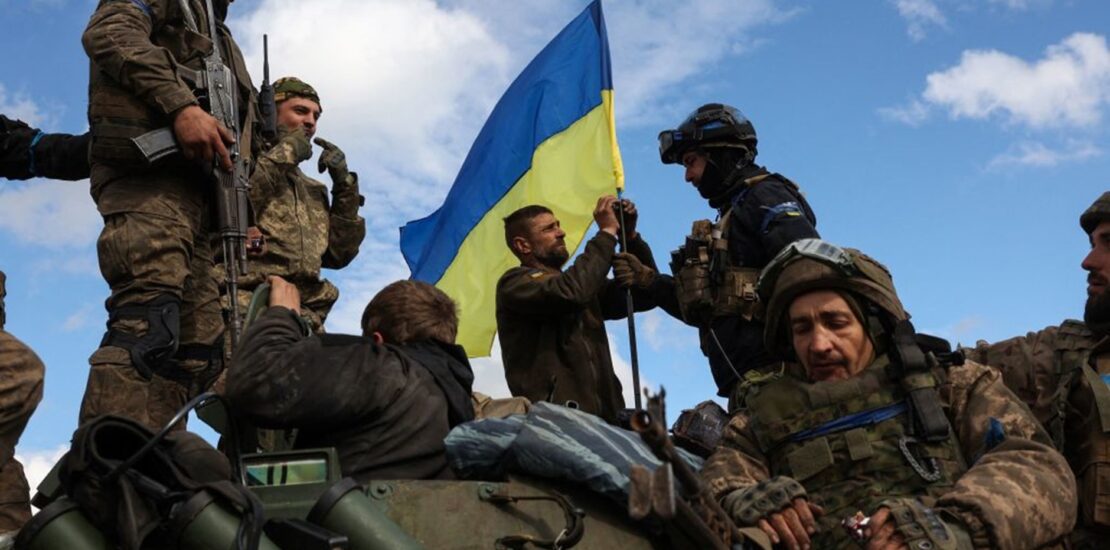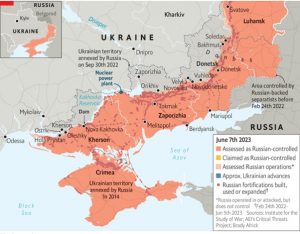Ukraine’s Offensive: Is This The Last-Ditch Battle?
- July 6, 2023
- Posted by: admin
- Categories: Russia, Ukraine

By: Lt Gen Syed Ata Hasnain (Retd)
In the context of the Russia-Ukraine war, since April 2023 we have been constantly hearing of a likely ‘counter-offensive’ by Ukraine to overcome the negatives of the alleged defeat at Bakhmut where a battle of attrition raged for the last ten months. An offensive action by the Ukrainian army has commenced since early June 2023. It was slightly delayed but has succeeded in securing some initial successes by occupying or securing a few villages not far from the frontline. This is the fourth cycle of offensive action in the Russia-Ukraine War which is raging in East Central Europe since February 24, 2022 (D-Day).
The first cycle involved the Russian forces’ opening offensive, which commenced on D-Day. When the Russian war machine could not make much headway, the Ukrainian Army launched the next offensive cycle on 29 Aug 2022 to roll back the Russians, often attacking the bases of the Russian forces in what the media termed ‘counter-offensives’. These reached 10-15 kilometers into Russian territory in the north and made some penetrations in the East, but it wasn’t enough to turn full flanks or cause the Russians to withdraw. The third cycle of offensive operations involved the slugfest at Bakhmut where Russia deployed the Wagner Group. Alongside the ten-month-long battle, Russia employed mass artillery strikes against population centers and some troop concentrations causing immense destruction of property and fairly large civilian casualties. Reasonable territorial gains came their way along the south and east.
So, we are now witnessing the fourth cycle of offensive operations. Before going into further analysis it is important to play to the gallery and the grandstand, both of whom are up in arms to discern many of the tactical terms that have been loosely used by the international media and lapped up by our media too. In Indian Army terms, an operation to recapture lost ground is always referred to as a ‘Counter-Attack’ and the strength required for this is far lower than a regular attack operation. What precedes a Counter-Attack is usually a Counter-Penetration, to limit the advance of the adversary. There are time limits for Counter-Attacks which are usually launched before the adversary consolidates on the ground that he has captured. A Counter-Offensive is usually launched into adversary territory with deep penetration being the aim. Besides striking deep, for which a higher quantum of troops is required, the intent is to unhinge the defences, capture territory and draw the reserves into the battle. None of these terminologies seem to fit here. The label which is more appropriate for application in this setting is ‘Riposte’, which too is an offensive but of more limited proportions and with an intent to target the bases of the adversary from where he launched his operations, to force him to retract.
None of the above is important for laymen, but in today’s world, military intellectualism has seeped into the citizenry, a very welcome development indeed. It demands that wrong terminologies are not used and explanations of military situations be completely professional. For public knowledge, it is important to do some stocktaking of the war front, a resource analysis, an appreciation of the application of Ukrainian forces and the likely outcome. These are not blind offensive operations that are purely attritional. Hereafter there is likely to be greater use of mechanized forces and artillery accompanied by drones and missiles. Of course, we have seen some very heavy artillery assaults on Ukrainian built-up areas without any Russian remorse for the fatalities that civilians suffer. There hasn’t been sufficient concern expressed by the international community towards this aspect and Russian artillery has not held back.


Image Source: The Economist 07 June 2023
The Russians had advanced in the south, center, and east establishing a continuous line, and had also laid obstacles to prevent the easy advance of the Ukrainians. Yet there isn’t a continuous line that they are holding. NATO Satellite surveillance will give away the dispositions and the gaps which could be exploited by Ukrainians to maneuver and engage the Russians from the rear. For that to happen, they need sufficient troops, especially the mechanized infantry.
From all indicators, Ukraine may have received 8-9 brigades of fresh troops recently equipped and trained under the NATO flag. Another 6-7 are re-mustered formations from the frontlines and the rear, making a force of approximately 15 brigades. It is highly unlikely that these will be applied concentrated in one area/region to make a penetration. More likely multiple points of breach will be selected along the front. The area in the south is ruled out due to the breaching of the Kakhovka dam which makes movement of armour impossible. It’s the central sector with the alignment along Zaporizhian to Tokamak and Berdiansk that is important. Any military mind will assess that the penetration of this area will afford the Ukrainians the opportunity to split the Russian front into two, and if it can be held against counter-attacks that are bound to follow; then Ukraine would have scored a major military success. The Russians will be forced to defend and recapture simultaneously preventing them from undertaking operations elsewhere. NATO military leaders would be assessing the options and will probably find this the most lucrative, but it would need a sizable number of troops to achieve a break-in. Ukraine’s formations will try typically what is often referred to in our army as ‘contact on a broad front’. However, breaches would be executed at a few points with an immense amount of deception. With drones at the ready, battlefield surveillance itself will negate some of the deceptions. The next set of slogging matches is therefore likely to occur along this front. Ukraine will need to maintain a set of reserves to exploit breaches, something along the lines of what they did in Sep 2022.
Ukraine also has the option of balancing itself in its application of forces. To get to Donetsk and the Donbas region in the east it will again need to detach a major chunk of the 15 brigades. What has to be remembered in the application of forces is that it cannot be done in driblets, hoping to cash in on small successes. At least 5-6 brigades will need to be employed here if anything meaningful is to emerge. So, it appears that approximately two division-size forces each will be required in the East and the Centre with a division standing by as reserve. These have to be backed by armed drones, missiles, and artillery. Once into the built-up areas, it may again be like Bakhmut. At this stage, we can only assess a 50:50 chance of these operations meeting their objectives. The Ukrainians are still probing; probably some kind of recce in force to determine the layout or confirm what they see through satellite surveillance. The routes to Ukraine’s coast – its own coast – have layer upon layer of Russian minefields, concrete tank blockers, bunkers, firing positions, and trenches wide enough and deep enough to stop a Leopard 2 or M1 Abrams tank literally in its tracks. All of these are covered by pre-determined artillery impact zones calibrated to rain down high explosives on Ukraine’s armoured vehicles as they wait for routes to be created. Their formations may not yet have come into battle.
While going to print it emerges that Putin, in an interaction with bloggers, has admitted that some battles have taken place in the east with the Ukrainians allegedly losing over 160 tanks at the cost of 54 Russian tanks. None of this information is reliable as information warfare remains rife. We will have to await some unbiased reports for an idea of the real situation.
The other question, Is this the last stand by both sides? The Russians have not been able to do anything beyond Bakhmut except for redeeming the name of their infantry which too was essentially Wagner’s infantry. Exploitation usually follows a hard-fought breakthrough but the Russians do not seem, at present, to have the will nor the resources to risk offensive action. They are probably hoping to cause serious attrition on the Ukrainian forces now on the offensive; the attacker invariably suffers more loss of resources, material, or personnel . For NATO and Ukraine, this may be the last initiative to try and secure a military victory, but prudence dictates that there will be more stalemates and nothing decisive will emerge. The swan song of this war could be one last effort by Putin once the Ukrainian offensive has lost weight and energy. A period of ‘No War No Peace’ could follow through non-negotiated deals. The ultimate decision towards a negotiated peace could only come once NATO and Ukraine accept the loss of territories in Donbas and along the coast as fait accompli and Putin pushes for no more territorial gains. The million-dollar question that will remain is whether Ukraine’s membership in NATO will be acceptable to Russia with Donbas and Crimea under its belt.


Lt Gen Syed Ata Hasnain (Retd)
AUTHOR
Lt Gen Syed Ata Hasnain (Retd), PVSM, UYSM, AVSM, SM, VSM* former Commander of Indian Army’s Srinagar Corps, focuses on trans-national and internal conflicts in Asia and the Middle East with particular emphasis on issues revolving around radical Islam. He is the Chancellor of Central University of Kashmir and speaks extensively at Indian and international institutions on a wide variety of subjects revolving around strategic affairs and leadership. He is presently a Member of the National Disaster Management Authority (NDMA).
